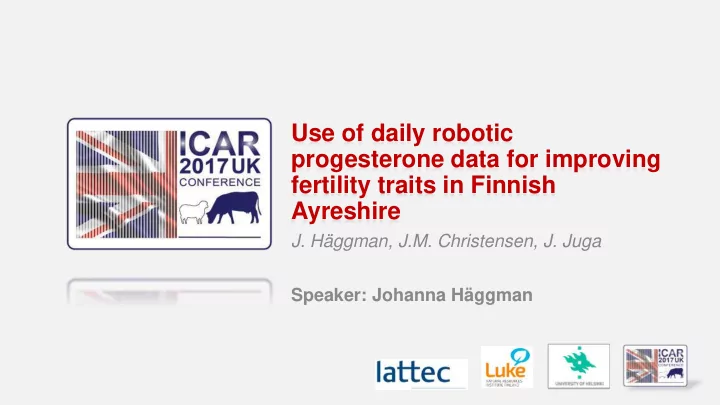

Use of daily robotic progesterone data for improving fertility traits in Finnish Ayreshire J. Häggman, J.M. Christensen, J. Juga Speaker: Johanna Häggman
Background C ow’s ability to return to cyclicity after calving is mostly evaluated using the first insemination measurements (CFI) Traditional fertility traits, such as CFI, have low heritabilities and are highly influenced by management decisions If consecutive progesterone measurements are used the first heat can be identified accurately Several studies have revealed that endocrine fertility traits have higher heritabilities than traditional fertility traits
Herd Navigator (HN) – progesterone data Sampling and analysis of milk automatically during milking Recording begins 20 d after calving Progesterone values are smoothed using an extended Kalman filter and biomodel is used to predict the reproductive status of the cow (Friggens & Chagunda 2005; Friggens et al. 2008) 0 = postpartum anoestrus 1 = oestrus cycling 2 = potentially pregnant Calculates days to next sample (DNS)
Progesterone traits CFH (days from calving to first heat observed by HN system) C-LA (days from calving to luteal activity) is calculated as a reproduction status change from 0 (Anoestrus) to 1 (Cyclic) or 2 (Potential pregnant) C-LA = (“first time status 1 or 2” – “last time status 0”)/2 + “last time status 0” – “Calving Date”
Materials 14 HN herds from Finland 1230 Ayrshire cows from parities 1-3 were included in the analysis Years 2014-2017 some herds joined later: 6 herds in 2015, 3 herds in 2016 Daily progesterone data (provided by Lattec I/S) Pedigree, test day and insemination data (provided by Faba)
Data restrictions (first parity) CFH ≤ 100 d CFI ≤ 230 d CLA ≤ 100 d Analysis between CFH and traditional fertility traits (data 1): Trait N-obs Average S.D. Min value Max value CFI 676 78.9 15.8 46.0 184.0 CLI 676 109.3 43.0 52.0 296.0 IFL 676 30.3 40.4 0.0 234.0 CFH 676 49.9 17.7 22.0 100.0 Analysis between CFH and CLA (data 2): Trait N-obs Average S.D. Min value Max value CFH 723 48.4 17.1 22. 0 100.0 CLA 723 38.1 15.7 20.6 89.6 CFI= calving to first insemination, CLI=calving to last insemination, IFL=interval from first to last insemination, CFH=calving to first heat, CLA=calving to luteal activity
Methods DMU software (Madsen & Jensen 2013) Genetic analyses mainly for parity 1 Linear animal model y = herd + calv_year + calv_month + calv_age + animal + e Interactions were not included because of the small data size
Results, phenotypic Table: Mean frequencies for fertility traits (d) Trait Parity 1 Parity 2 Parity 3 Calving to first heat 49.9 58.0 65.8 Calving to first insemination 78.9 81.7 86.5 First to last insemination 30.5 35.5 38.7 Calving to luteal activity (data 2) 39.9 37.7 40.6 Most of the cows in the data had been inseminated for the second heat identified by the HN system First 17.3%, Second 31.2%, Third 18.5% Mean number of inseminations in HN herds was around 2 for all parities
Results, phenotypic When phenotypic estimates were compared to those from previous studies (Kargo et al. 2014, Muuttoranta et al. 2015): CFI was 4.5d and IFL 10.3d shorter in HN herds for first parity cows CFI was 1d and 5.7d longer in HN herds for parities 2 and 3, respectively IFL was 6.6d and 4.9d shorter in HN herds for parities 2 and 3, respectively According to previous studies the average cost of CFI is 0.51 € /d and IFL is 2.56 € /d for the red dairy breed
Results, heritabilities Heritability estimates for first parity cows (data 1): CFH 0.27±0.13 CFI 0.07±0.07 CLI 0.06±0.07 IFL 0.03±0.06 Table: heritabilities (±SE) for commencement of luteal activity for parity 1 and parities 1-3 (data 2) log(C-LA) 1 C-LA round(C-LA) Parity 1 (n=766) 0.23 (0.12) 0.17(0.10) 0.24(0.12) Parities 1-3 (n=1933)* 0.05 0.07 0.06 Parities 1-3 0.22(0.04) 0.23(0.04) 0.22(0.04) *permanent environment factor included in the model 1 natural logarithm
Results, correlations Correlation between CFH and C-LA (data 2) for first parity cows was high (genetic 0.95±0.06, phenotypic 0.90) In this dataset the heritabilities were lower than in univariate analysis, being: CFH 0.20±0.12 C-LA 0.14±0.11 Correlation between CFH and CFI (data 1) for first parity cows was low (genetic 0.12±0.55, phenotypic 0.21)
Conclusions Using milk progesterone information to detect heats shortened CFI in first parity cows. Using milk progesterone information to detect heats shortened IFL in parity 1-3 cows. Progesterone traits (CFH, C-LA) were more heritable than traditional fertility traits. Some of the standard errors were high because of the small data size. However, these results are promising and new analysis can be done in the future when more data is available. It´s important that this kind of data from automatic devices is available to recording and breeding organizations in the future
Questions? • This research is part of FINFERT project which is part of a inter-Nordic research project NORFERT • Participants: Natural Resources Institute of Finland (Luke), Helsinki University (HU) • Industry partners: Faba Coop, Viking Genetics, Valio Ltd, ProAgria Advisory Center, Nordic Cattle Genetic Evaluation Ltd (NAV), Lattec I/S • NORFERT partners : AU Denmark, SLU Sweden, NMBU Norway
Recommend
More recommend